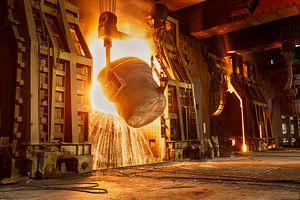China has faced a steel glut since 2014, when a real estate and debt shock forced demand for construction materials into a nosedive. China has been trying to cope with excess inventories both by cutting capacity in the sector and by reducing existing stocks of steel. China’s leadership is now encouraging steel overcapacity to move overseas. Despite the fact that the U.S. and Europe have been complaining about China’s copious exports of steel into these nations, Chinese banks have been told to finance steel exports.
Steel demand has slowed as China’s rate of construction in housing and infrastructure and manufacturing production have declined. Before the decline truly set in, China accounted, in 2014, for about half of global steel demand. At present, although demand is waning, China continues to produce about half of the global steel supply.
China’s excess supply of steel has pushed down steel prices around the world. Last Tuesday, the U.S., Canada, the European Union, Japan, Mexico, South Korea, Switzerland and Turkey issued a statement asking nations to reduce their supply of steel. China was not part of this joint effort. Steelworkers in the U.K. and Germany have suffered, with U.K. workers facing jobs cuts and German workers staging national protests. The U.S. imposed antidumping tariffs on Chinese steel last month, while the EU did so last year. China retaliated by placing dumping duties on EU steel (and on Japanese and Korean steel).
China’s recent order requiring banks to finance steel exports represents an act of ill faith toward the U.S. and EU in particular, which have suffered from China’s low-price steel exports. As part of a global oligopolistic industry, in which a few firms dominate, steel firms should engage with the rest of the world. Failure to do so has resulted in declining profits for all steel firms and has created mistrust among non-Chinese players for Chinese firms. In return, the European Union has been loath to grant China Market Economy Status, which would allow Chinese firms to more easily justify their actions in WTO anti-dumping cases.
Although it appears that China’s leadership wants to eliminate excess inventories of steel right away, the industry may be better off if the government chooses to purchase and hold stores of steel until demand rises, as it does for agricultural products. The incentive to export rather than hold steel comes from firms’ desire to lock in higher prices as steel prices continue to slide, and from firms’ need to stay productive rather than temporarily close and write down bad loans.
As a result, both steel firms and their government advocates remain fixed on short-term outcomes and are not playing the long game. In the long or even medium run, China is committed to expanding urbanization. It will need a great deal of steel for this process. A steady rise in demand for steel will hike world prices. China will also have to continue to engage with its trading partners, and its dumping practices are generating some bad blood among its Western counterparts. Even if steel mills remain open and produce at a break-even level, storing steel inventories may result in higher prices and better trading conditions than exporting the glut to disenchanted foreign markets.
While China’s reduction of steel capacity is a smart move at present, trade-related steel policies need to be revisited. If these policies are not altered, the industry and its workers will continue to suffer.

































